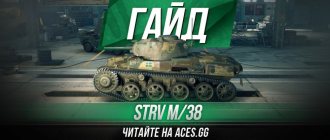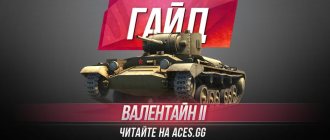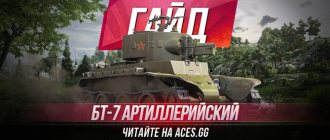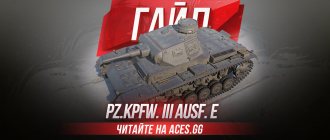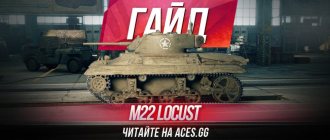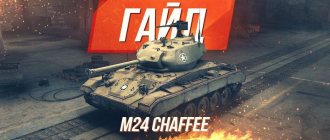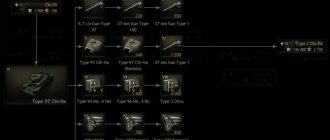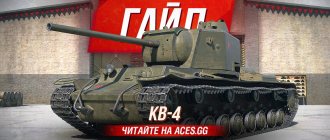Good day, dear tankers, welcome to aces.gg! Now we will talk about a vehicle that is very unusual for its level and class of equipment, a French light tank of the second level - this is the Hotchkiss H35 guide
.
The fact is that this device is more reminiscent of a heavy tank, however, not everything about it is as simple as it might seem at first glance. For this reason, it makes sense to talk about the features of the Hotchkiss H35 WoT
, consider in detail its characteristics, strengths and weaknesses, as well as everything else.
TTX Hotchkiss H35
First of all, every player behind the wheel of this miracle of French thought needs to understand that the car has an absolutely standard safety margin for its level and, no less important, a mediocre viewing range of 300 meters.
If we talk about the characteristics of the Hotchkiss H35
reservations, initially it seems that in front of us is a really heavy vehicle, with excellent armor by the standards of its classmates, which is good no matter which way you look at it.
However, when considering the collage model, it becomes clear that everything is not so smooth. Indeed, in most areas in the forehead, everywhere on the sides and even from the stern, the French light tank Hotchkiss H35
has from 40 to 56 millimeters of armor (back and side), as well as from 40 to 109 millimeters from the forehead. That is, classmates with good penetration, for example, tank destroyers, have a chance to inflict damage on us, but all sorts of machine guns and weak guns will not be able to penetrate us.
But in the frontal projection we notice areas of yellow color, and here is the Hotchkiss H35 WoT
has 30 millimeters of armor and if the yellow section of the VLD, due to its excellent slope, is the thickest part of the vehicle (the same 109 mm), then the hatch on the hull and the “blot” around the gun are broken through by many. This means that if you come across an experienced enemy, things will be bad, although our vehicle is still very well armored, since there are few experienced enemies at level 2.
In addition to having really good armor, albeit with a couple of weak points, the Hotchkiss H35 tank
has become the owner of compact dimensions and a low silhouette, thanks to which we have at our disposal not only good camouflage, but simply hiding behind some stone will not be difficult.
And now I’ll tell you about another feature of this device, because of which it again becomes more like a cord - mobility. Of course, you have to pay for decent armor, so Hotchkiss H35 World of Tanks
became the owner of a very low maximum speed, very fast dynamics, but at the same time good maneuverability.
Rejected by the infantry, attracted by the cavalry
The French army met World War II armed with three types of modern light tanks.
Warspot articles about two of them : these are numerous Renault R 35 , as well as FCM 36 , which entered service with two tank battalions. The third and most numerous type was the Hotchkiss H 35 (as well as its improved variant, the H 39 ). Based on the totality of its characteristics, the H 39 turned out to be the best French light tank: it turned out to be quite reliable and more mobile than the rest of its classmates.
Casting as an engine of progress
The beginning of the 30s in the world tank building was a time of experimentation. This is also true for France. In the 20s, the French military could not decide what exactly they needed, and manufacturers often offered customers very specific vehicles. As a result, by the beginning of the 30s, only one new tank entered service with the French army - the Renault D1. The vehicle turned out to be, to put it mildly, strange: with a combat weight of 14 tons, this tank was considered light, although some medium-sized vehicles of that time weighed less. This tank never became truly mass-produced, and its development turned out to be not a light, but quite a medium-sized Renault D2. In pursuit of improved performance, the French military made their light tank too large and expensive.
The first prototype of the Hotchkiss light tank, January 1935
At that time, tank hulls were assembled mainly using slats and rivets. Welding technology was just beginning to spread at that time. The pioneers here were the Germans, who welded the hulls of the Großtraktor medium tanks and the Leichttraktor light tanks. True, no one knew about this except the Germans themselves and Soviet specialists, since these combat vehicles were built illegally.
Another method of manufacturing tank hulls and turrets was casting. For the first time, cast parts were used on the Renault FT. Casting made it possible to make large and complex parts without additional connections. But nothing larger than the turret and individual hull elements was made by casting until the early 30s. Tanks then had bulletproof armor only about 15 mm thick, and there was little point in using casting.
The same car in the back of a truck
In the 20s in France, Renault had no competitors in the field of tank building. FAMH's attempts to produce 3-ton wedges ended in failure. The situation changed in the early 30s, when the Hotchkiss company began to test the waters. Before this, the arms giant had not dealt with tanks, limiting itself to armored cars.
Hotchkiss began working on tanks thanks to Henry Mann Ainsworth, the company's CEO. A former British officer and a big fan of cars, Ainsworth closely followed the development of world tank construction. The problems of this industry in France did not escape him either. It was Ainsworth who came up with the idea of creating a vehicle with a combat weight of 5-6 tons, which could replace the obsolete Renault FT in the army. To reduce the combat weight, Ainsworth proposed abandoning the turret, configuring the vehicle according to the type of the English Carden-Loyd wedge. The driver and commander, who is also a machine gunner, would sit shoulder to shoulder in this car. Unlike the Renault FT and its “descendants,” the transmission was moved from the rear of the tank to the bow. This solution, also taken from the English wedge, made it possible to reduce the length of the body.
The first two experimental chassis were distinguished by a characteristic “hump” of the engine plate
This is where the borrowings ended, and original technical solutions began. The suspension with horizontally located springs as elastic elements turned out to be extremely interesting. 6 small diameter road wheels on each side were interlocked into 3 bogies.
The most important innovation was the method of manufacturing the case. All its main parts were made by casting and connected to each other with bolts. Only the bottom sheets were not cast. This technology significantly simplified assembly.
The third example received a new hull top, as well as an early version of the APX R turret
The development of a promising combat vehicle began in the spring of 1933, and already in June the concept of a light tank was discussed at the Armaments Advisory Council (Conseilatif de l'armement). Its participants found the idea extremely interesting, since the tank was inexpensive and, as a result, widespread. On June 30, a contract was signed for the production of three prototypes.
The activities of Hotchkiss did not go unnoticed by its competitors, especially the main one - Renault. On August 2, 1933, the military formulated requirements for the development of a new light tank. According to them, the new tank was supposed to have 30 mm thick armor and be armed with either two machine guns or a 37 mm cannon. In fact, the requirements repeated Ainsworth's proposal, differing from it in the presence of a tower. Organized by the French infantry command, the competition attracted the attention of 14 companies, including Hotchkiss and Renault.
During testing, the Hotchkiss tank turned out to be faster than the Renault ZM, but the infantry command had already made a choice
Renault designers were among the first to cope with the task. Taking the Renault VM small reconnaissance tank as a basis, they built the Renault ZM light tank on its basis. Coincidentally, this machine also had a cast body. APX has prepared a similar design. The high pace that Renault imposed allowed it to quickly break away from its competitors. Even the change in specifications that occurred on May 22, 1934 did not interfere. In accordance with the new document, the armor thickness increased to 40 mm, which made it possible to protect the vehicle from 25 mm cannon fire. Its maximum speed increased to 15-20 km/h, and its combat weight also increased.
Hotchkiss presented the first prototype of the turretless fighting vehicle only in January 1935. A little later a second sample appeared. The cars turned out to be damp, as shown by tests conducted from January to May 1935. True, despite all the defects, the prototypes, which had a combat weight of 8.5 tons, turned out to be 8-10 km/h faster than the Renault ZM. This advantage, however, did not particularly interest the infantry command. On April 29, 1935, the Renault ZM was put into service under the designation Char léger Modèle 1935 R (light tank model 1935).
Despite this, in August 1935, Hotchkiss released a third prototype. It was very similar to the first two, but the top section was redesigned. The driver moved to the right, and the commander, also known as the gunner/loader, now sat in the turret of the APX R. This vehicle was tested in August-September 1935, and it also turned out to be faster than the Renault ZM.
But the infantry command has already decided on the choice in favor of the brainchild of Renault. In addition, there was also the FCM Tracteur RN3, later adopted as the FCM 36. The Hotchkiss tank turned out to be the third wheel. On this, it would seem, his story should have ended. But then the cavalry became interested in the car.
Budget option for French cavalry
At first, the French cavalrymen had no plans to purchase light tanks. To equip the cuirassier (essentially tank) divisions, it needed other vehicles - AMC (Automitrailleuse de combat, “armored combat vehicle”). This is exactly the armored vehicle (actually a medium tank) that was developed at SOMUA. The AC 3 model with some modifications was adopted on March 25, 1936 as the Automitrailleuse de Combat modèle 1935 S. The serial AC 4 is better known as the SOMUA S 35.
According to plans dated November 21, 1935, it was planned to purchase 600 of these tanks. True, here two problems stood in the way of the command of the French cavalry - production and financial. The SOMUA plant was physically unable to quickly build so many tanks, and the price of 982,000 francs looked exorbitant. For that kind of money you could buy several light tanks. At the end of 1935, the cavalry command drew attention to the brainchild of Hotchkiss.
Pre-production vehicle, slightly different from the production H 35 in small details
It cannot be said that the characteristics of this light tank were amazing. Its maximum speed was 2 times less than that of the AMR 35ZT, and the 37-mm SA 18 cannon could not be compared with the 47-mm SA 35 cannon, which was installed on the SOMUA S 35. Nevertheless, the vehicle had almost 1 .5 times higher mobility than the Renault R 35, with the same armament and protection. In addition, the driver in the Hotchkiss tank had better visibility, and the vehicle itself weighed half a ton less than its main competitor. In addition, Hotchkiss's production capabilities made it possible to quickly establish mass and, most importantly, inexpensive production of tanks: their cost was not much higher than that of the Renault R 35.
Scheme of serial Hotchkiss H 35
In November 1935, the tank was adopted by the French cavalry as the Char léger Modèle 1935 H, DIT, better known as the Hotchkiss H 35. An order was placed for 200 tanks, which were supplied to the 1st and 2nd Panzer Divisions. Based on the test results, a lot of changes were made to the design of the machine. The first to receive them was an experimental vehicle with registration number 8533-W1. The chassis - bogies and drive wheels - underwent significant modifications. The number of support rollers was reduced to two. In order to improve protection and manufacturability, the body was also redesigned. The engine plate has been redesigned, resulting in improved access to the power plant. The design of the tower has changed slightly.
Diagram of the tank hull, which clearly shows what parts it consists of and how the parts are connected to each other
After testing the prototype and making minor additional changes to the design, production of the serial tank began. The French cavalry command, satisfied with the test results of the improved prototype, placed an additional order for 100 tanks. Production vehicles received serial numbers that began with 40001. The first tanks were delivered in July 1936. By French standards, the pace of production was quite good. The plan to produce 300 tanks was completed long before the start of World War II - in November 1937. Later production vehicles received turrets with improved viewing devices that were less vulnerable to enemy fire.
Serial H 35. Factory camouflage applied to the vehicle
Another 100 tanks were ordered by the French infantry command. They were made in 1938. These vehicles were used to recruit the 13th and 38th tank battalions. Thanks to this order, the infantry was able to save money: competition forced Renault to become more accommodating. The cost of R 35 decreased by 60 thousand francs.
“Cavalry” Hotchkiss H 35 by September 1, 1939 were part of 11 squadrons. The 12th Squadron was re-equipped with these tanks from the AMC 35.
The same tank on the left
Back in the late 30s, the long-barreled SA 38 gun was developed, which made it possible to hit tanks with armor 38 mm thick and was suitable for installation in light tanks. But it was only in February 1940 that this weapon finally went into large production. First of all, newly produced tanks received it, but, whenever possible, already produced vehicles, both Renault R 35 and Hotchkiss H 35, were also rearmed.
Re-equipped with the SA 38 and equipped with a radio, the commander's H 35 leads the column of vehicles still equipped with short-barreled guns.
By the beginning of the war, the new weapons could only be stopped at some tanks. First of all, the vehicles of platoon commanders received it. Also, some of the command vehicles received ER 29 radios. Another element that not all tanks received was a “tail” for crossing deep trenches - this will be discussed in more detail below.
Additional fifty horses
The Hotchkiss H 35 was noticeably more agile than the Renault R 35, but the lack of engine power was still noticeable. A 75-horsepower engine was enough to accompany motorized columns, but a light tank could no longer keep up with the SOMUA S 35. Work on modernization in this direction began in 1937.
The redesigned hull that the H 39 received. The biggest change was the engine plate, which became larger due to the installation of a larger and more powerful engine.
In the 1930s, Hotchkiss sports cars won the famous Monte Carlo Rally four times. Special racing cars with new engines were prepared for these competitions. Just one such engine with a power of 117 horsepower was installed on a tank as an experiment. The results were contradictory. On the one hand, the maximum speed increased to an impressive 45 km/h, which was even higher than that of the SOMUA S 35. On the other hand, problems arose with the gearbox, which was not suitable for transmitting such power. As a result, the tank drove quickly, but not for long. The second problem was the rapid wear of the rubber bands. Having solved the problem of insufficient mobility, the Hotchkiss design team encountered new troubles.
General diagram of Hotchkiss H 39
The French solved the problem of peeling tires quite simply: they began to make the road wheels all-metal. A new power unit was developed based on the racing engine. It also had 6 cylinders, but its displacement increased to 5.96 liters, and maximum power increased to 120 horsepower. The new engine was too large; the engine compartment had to be remodeled to fit it, which received a different engine plate. The combat weight of the tank increased from 11.7 to 13.2 tons, but due to the increase in engine power by one and a half times, its mobility increased noticeably. The maximum speed increased to 36.7 km/h and became approximately equal to foreign “classmates”, such as the Pz.Kpfw.II.
The increase in power and combat weight affected fuel consumption. Now on one refueling the tank could cover only 120 km instead of 150 for the H 35.
More than half of the H 39 received SA 18 short-barreled guns. Such vehicles are often mistakenly called H 38, which is fundamentally incorrect
The converted car was designated at the company as Char léger modèle 1938 série D, but the sometimes encountered designation Hotchkiss H 38 has no basis. The new vehicle was accepted into service on February 18, 1939 as the Char léger modèle 1935 H modifié 1939. This tank is better known as the Hotchkiss H 39. The first vehicle, serial number 40401, was delivered in March 1939.
After replacing the engines, the command of the French infantry became the main customer of the very tanks that it had once abandoned. By September 1, 1939, the cavalry received only 16 H 39s, while the infantry had 180 of these tanks, organized into 4 battalions (14 of this number were in reserve, 4 were in workshops). In addition, 3 tanks were sent to Poland in July 1939.
Delivery of batch H 39 with SH 38 guns, spring 1940. These tanks are already equipped with tails, on which a spare roller and a spare parts box were attached.
With the outbreak of World War II, orders for tank production increased sharply. Every month the military wanted to receive 300 H 39. This figure was simply unrealistic for a relatively small enterprise. But in parallel with tanks, Hotchkiss also produced artillery tractors developed by Laffly. Therefore, production volumes of H 39 increased very slowly. If in September 1939 it was possible to deliver 20 tanks, in February 1940 69 vehicles were built in Saint-Denis. Just at this time, production of the 37-mm SA 38 gun finally began. In total, the French managed to produce about 800 of these guns, and they were first installed in the H 39. Of the 557 such tanks manufactured by May 1, 1940 , about a third received long-barreled guns.
By May 10, cavalry units had 252 H 39s (of which 50 were in workshops and training units), and infantry units had 271 (of which 48 were in workshops and training units). 2 more tanks were sold to Turkey in February 1940.
Unused reserves for the hulls and turrets of the H 39, which fell to the Germans. June 1940
Hotchkiss H 39 production peaked in May 1940, with 122 tanks delivered that month. In June, another 33 vehicles were built. Thus, a total of 710 Hotchkiss H 39 tanks were built. Together with the H 35, the total number of Hotchkiss tanks produced was 1,110 units. Not bad for a car that was once abandoned by the military!
Best of the worst
Hotchkiss and Renault R 35 had the same weapons and comparable protection. True, the H 35/H 39 had some advantage due to the fact that the armor of the turret box in the front part was located at a more rational angle. However, this did not really change the overall picture. 40 mm of cast armor was not enough for reliable protection against anti-tank artillery: the 3.7 cm Pak reliably hit these tanks at distances of up to 300 meters.
H 39, equipped with AMX chassis
The main advantage of the H 35 and especially the H 39 was speed. In addition, it quickly became clear that the chassis of the Renault R 35 does not behave very well off-road. And here the Hotchkiss light tanks also looked preferable. This fact did not prevent the AMX company from offering in 1939 a chassis similar to the one that was later used on the AMX 40. After testing, it was abandoned because it was suitable for a slow tank.
But another innovation, created to improve the tank’s maneuverability, has caught on. We are talking about the “tail”, which made it possible to improve the permeability through ditches and trenches. In 1939, two types of such devices were tested - those developed by Hotchkiss and AMX. The first of them went into mass production. In addition to new tanks, previously released tanks also received a tail. A spare road wheel was moved to it, and a spare parts box was also attached to parts of the tanks.
H 35s are moving towards the front line. Ardennes, May 1940
"Cavalry" H 39s entered service with squadrons, each of which had 47 tanks. In the infantry, these tanks equipped tank battalions (45 vehicles each). Already during the war, units appeared in which the regular number of tanks was different, usually smaller. For the cavalry, these were armored car regiments (Régiment d'automitrailleuses, or RAM), which each had 16 tanks. By May 1940, 5 such regiments were formed. The infantry had separate tank regiments (15-16 tanks each).
Cast armor confidently protected against 20-mm automatic cannon shells. With 37 mm shells the situation was worse - at a distance of 300 meters and closer, 40 mm armor was penetrated
The Hotchkiss H 39 was the first French tank to participate in full-scale combat against the Germans. This happened at the beginning of May 1940 in Norway. The 342nd separate tank regiment was sent north to possibly help the Finns, but had to fight against their future allies. Of the 15 tanks, 5 actually took part in battles, of which 3 were lost. The surviving 12 tanks were evacuated to England and were later used by the 1st Free French Tank Regiment.
Despite the fact that the H 39 turned out to be the best French light tank, it did not have much influence on the overall course of hostilities.
During the battles in France, the H 35 and H 39 were used very actively. Many H 39s received long-barreled guns; such tanks turned out to be much more dangerous for the Germans than the R 35 and FCM 36. And in terms of mobility, the Hotchkiss light tanks were not particularly inferior to the German light tanks. The weak point of the French light tanks was the lack of radio communications (walkie-talkies were only on command vehicles), and visibility was far from ideal. And the very concept of a small two-seater tank was outdated by that time.
However, German light tanks did not stand out for the better compared to the H 39. But the main striking force of the Wehrmacht were the medium Pz.Kpfw.III and Pz.Kpfw.IV, as well as the Czechoslovakian Pz.Kpfw.38. Compared to these vehicles, French light tanks looked pale, and the French were in trouble with medium tanks. French tank crews fought fiercely, especially in the Ardennes, but the French army lasted less than a month and a half of active combat against the Wehrmacht.
A detailed photo review of the “Hotchkiss” preserved in the collection of the museum in Kubinka can be viewed by following the link.
Sources:
- Materials Center des archives de l'Armement et du personnel civil (CAAPC)
- Hotchkiss H 35/H 39, Pascal Danjou, TRACKSTORY No. 6, 2006
- Hotchkiss H 39, Pascal Danjou, Focus No. 5, 2009
- The Encyclopedia of French Tanks and Armored Fighting Vehicles: 1914-1940, François Vauvillier, Histoire & Collections, 2014
- GBM 74, 75, 112, HS1
- Photo archive of the author
gun
If we consider the general performance characteristics of our Frenchman not unusual, but strange for the LT-2, then the armament will be an even stranger part of the vehicle, since the gun is very different from what is commonly found among its classmates.
First of all, we are talking about the fact that the Hotchkiss H35 gun
has a very small alpha strike and even a high rate of fire does not correct the fact that our damage per minute is low, only about 950 units.
In terms of penetration, Hotchkiss H35 World of Tanks
quite good, you can confidently inflict damage on every second-level enemy you encounter, but difficulties may arise with triplets, so if possible, it’s worth carrying some gold sub-calibers with you.
Exactly French light tank Hotchkiss H35
again not very good, this is due to the large dispersion of the gun (0.48 per 100 meters), practically absent stabilization, but at the same time quite good aiming speed, thanks to which the process of causing damage can still be called comfortable.
However, another important parameter is responsible for the comfort of shooting - vertical aiming angles, which in our case, to put it mildly, leave much to be desired. The problem is that Hotchkiss H35 WoT
can lower the barrel only 5 degrees down, which is very little.
Links[edit]
- ^ abcdefghijklmnopq François Vauvillier, 2011, "Gamelin im im le Hotchkiss à la Cavalerie", Histoire de Guerre, Blindés & Matériel
,
98
: 6–17 - AFV profile No. 36 page 18
- AFV Profile No. 36 page 20
- AFV profile No. 36 page 16
- AFV profile No. 36
- Pascal Danjou, 2006, “Les Hotchkiss H35 Réarmés”, Histoire de Guerre, Blindés et Matériel
N° 74, p. 81 - François Vauvillier, 2007, “Notre Cavalerie Mécanique son Apogee le 10 May 1940”, Histoire de Guerre, Blindés et MATERIEL
, N ° 75, p.49 - Tanks in Finland
- Kari Kuusela, ISBN 951-97506-3-0 - Tanks in Finland - Kari Kuusela, ISBN 951-97506-3-0
- "FMP - German Assault Gun Batteries 1943-1944". oocities.org
. - ^ ab "Panzerabteilung 206 and Panzer-Ersatz Abteilung 100 - Feldgrau.net". www.feldgrau.net
. - https://www.fireandfury.com/orbats/late21pzd6jun44.pdf
- Boisdron, Mathieu (December 2010). "Le Blindorama: La genèse de la force Blindée Bulgare 1935-1943." Batailles & Blindés
(in French). No. 40. Caraktère. pp. 4–7. ISSN 1765-0828. - Szabo, Christophe. "A 101-s harckocsiszázad vázlatos történelme". Katonaújság 2011/5
. Hermanos Kiado. Archived from the original on August 20, 2017. Retrieved April 26, 2014. - https://the.shadock.free.fr/Surviving_French_Tanks.pdf
- "Sous le sable... un char d'assaut". Le Parisien
. January 2009. Retrieved September 13, 2010.
Advantages and disadvantages
Since we have already highlighted the most important general characteristics of the tank, and also examined the parameters of its weapons, it’s time to take stock, that is, highlight the strengths and weaknesses of the Hotchkiss H35 World of Tanks
separately to make it easier for you to navigate the information provided. Pros: • Good all-round booking; • Compact dimensions and high level of camouflage; • Decent penetration rates; • Quite fast mixing. Cons: • There are vulnerable areas in the frontal armor; • Very weak mobility (especially maximum speed and dynamics); • Small margin of safety and viewing range; • Frankly small alphastrike and DPM; • Mediocre accuracy (scatter and stabilization); • Poor elevation angles.
Equipment for Hotchkiss H35
Even taking into account the fact that for second-level equipment the choice of additional modules is very scarce, this device can be strengthened quite well. However, we will act quite standardly, in other words, equipment for the Hotchkiss H35 tank
the following should be set: 1. – our aiming speed is good, but not ideal, so it makes sense to improve it in order to achieve a more comfortable process of causing damage. 2. is a universal and very popular module that simultaneously improves several important parameters. 3. or - depending on your playing style, you should choose one of these options, but given poor mobility and poor visibility, the best effect will be from the second module, because stopping costs you nothing, and the increase in viewing range is many times higher.
CONTENT
- 1 Development
- 2 Refusal by infantry and acceptance by cavalry
- 3 Description
- 4 Model Char leger 1935 H modifie 39
- 5 Operational history 5.1 France
- 5.2 Germany 5.2.1 Eastern Front
- 5.2.2 Balkans
- 5.2.3 Western Front
- 5.3.1 Poland
Equipment for Hotchkiss H35
Buying consumables for such an armadillo plays an equally important role; after all, there is a high probability that you will have to tank in battle and it would be nice to have at least a budget set of , , . But for maximum survivability and self-confidence, as well as in the presence of silver reserves, the Hotchkiss H35 equipment
It’s better to carry it in the form of , , . As for replacing the last option with , this option is possible, but even if there is armor, it is better not to expose the stern.
Game tactics on Hotchkiss H35
Unlike most second-tier light tanks, our strengths do not include mobility, and the gun at our disposal is quite strange, it’s hard to call it strong. However, the Hotchkiss H35 World of Tanks
there are other advantages, such as reservation, camouflage, armor penetration and others that need to be used.
Due to the fact that our Frenchman has good armor, it can be used, however, this does not mean that for the Hotchkiss H35 tactics
“eating and tanking” works best. No, we need to play moderately carefully and prudently, since even our classmates can break through us.
It is important to use armor wisely, that is, do not neglect various covers, because of which only part of your tank or even one tower will be visible. In addition, if you had to engage in close combat in open areas, try to install the French light tank Hotchkiss H35
diamond in order to increase the given armor. It wouldn’t hurt to dance a little from time to time to make it more difficult to target vulnerable areas.
As for dealing damage, this matter in our case is quite simple. First up, Hotchkiss H35 WoT
can play not from armor, but from camouflage, that is, stand in the bushes on the second line, close to the end and shoot at every convenient moment, taking advantage of good penetration. Secondly, when it comes to the first type of tactics, you just need to deal damage to the first target that presents itself, but I repeat once again, you should not drive into the thick of things.
Otherwise, actions in battle can develop in different ways, you just have to learn to act according to the situation, be moderately careful, follow the simple tips outlined above, and also remember that the Hotchkiss H35 is a tank
very vulnerable to artillery, that is, choose your routes and key positions wisely.
Surviving copies[ | ]
Tanks of this type (mainly models H 39.
) are represented in a number of museum collections and private collections[4]:
- H 35.
In the sea near Saint-Cecile beach. Camiers, Pas de Calais. The tower is missing. In very poor condition. - H 39.
On display at the Armored Museum in Saumur. In running condition. - 10.5cm leFH 18 auf Geschützwagen 38H (f).
On display at the Armored Museum in Saumur.
German self-propelled 105 mm howitzer on the H 39 chassis. - H 39.
On the territory of the Mourmelon military camp, Mourmelon-le-Grand. Turret from Renault R35, gun - mockup. - H 39
.
On display in the Patriot Park, Kubinka, Moscow region. Captured by the Germans and modernized Panzerkampfwagen 38H 735(f)
. Used in the 211th Tank Battalion near Murmansk, captured in September 1944. - H 39.
On display at the National Museum in Uzice. - H 39.
In the open exhibition of the National Museum of Military History, Sofia. - H 39.
In the Museum of the Israeli Armored Forces in Latrun. - H 39.
On the site in front of the Nordland Red Cross War Memorial Museum, Narvik. - H 39.
In the open exhibition of armored vehicles on the territory of the Rennes military camp, Rena. - H 39.
In the process of restoration on the territory of the Trandum military camp, Ullensaker. - H 39.
In a private collection. Raised from the swamp in 2015. - H 39.
Private collection of Kevin Wheatcroft, Wigston Magna, Leicestershire. Previously it was in the collection of the Military History Museum "Akerbus", Furre, Tyusver. - H 39.
In the collection of the Technical Center for Weapons and Ammunition of the Bundeswehr, Meppen. - Three chassis from H 39.
Private collection. Presumably they were used as tractors for German artillery.

